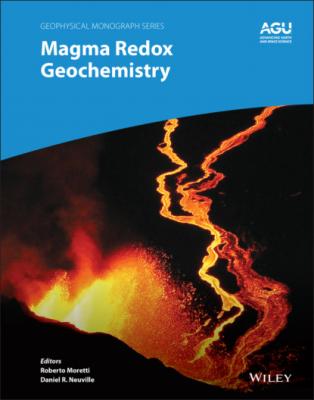Magma Redox Geochemistry. Группа авторов
Читать онлайн.| Название | Magma Redox Geochemistry |
|---|---|
| Автор произведения | Группа авторов |
| Жанр | Физика |
| Серия | |
| Издательство | Физика |
| Год выпуска | 0 |
| isbn | 9781119473244 |
Superposed on the upward mixing of post‐core formation oxidized mantle regions would be heterogeneities due to late accretion and associated downward mixing of late‐accreted material, which are difficult to quantify. For example, the abundance and partitioning of moderately siderophile elements apparently requires addition of increasingly oxidized material (Wood et al., 2006), whereas late meteoritic bombardment with reduced components has been inferred based on the Ce‐in‐zircon redox proxy (Yang et al., 2014). Wang and Becker (2013) suggest that volatile‐rich objects were involved based on Se–Te systematics, whereas Fischer‐Gödde and Kleine (2017) call for a reduced inner solar system source based on Ru isotopes. Thus, more work is required to quantitatively model the effects of downward mixing of late‐accreted material on mantle fO2 and to accurately capture the rise of post‐core formation oxidized lower mantle regions in numerical models. Pinpointing this evolution is critical to constraining the composition of gases released from Hadaean and Archean magmas to the atmosphere, which has implications for a multitude of issues affecting habitability on Earth, from the production of prebiotic molecules to the Faint Young Sun paradox and finally, the transition to an oxygenated atmosphere.
ACKNOWLEDGMENTS
V.S. acknowledges financial support from Sapienza University of Rome through “Bandi di Ateneo 2016 and 2019.” The Deutsche Forschungsgemeinschaft is acknowledged for funding under grant AU356/10 to S.A. The authors are grateful to two anonymous reviewers for their constructive comments.
REFERENCES
1 Allende Prieto, C., Lambert, D. L., & Asplund, M. (2002). A reappraisal of the solar photospheric C/O ratio. Astrophysical Journal Letters, 573, L137–L140. https://doi.org/10.1086/342095
2 Andrault, D., Muñoz, M., Pesce, G., Cerantola, V., Chumakov, A., Kantor, I., et al. (2018). Large oxygen excess in the primitive mantle could be the source of the Great Oxygenation Event. Geochemical Perspectives Letters, 6, 5–10. doi: 10.7185/geochemlet.1801
3 Armstrong, K., Frost, D. J., McCammon, C. A., Rubie, D. C, & Boffa Ballaran, T. (2019). Deep magma ocean formation set the oxidation state of Earth's mantle. Science, 365, 6456, 903–906. doi: 10.1126/science.aax8376
4 Aulbach S., & Stagno V. (2016). Evidence for a reducing Archean ambient mantle and its effects on the carbon cycle. Geology, 44, 9, 751–754. https://doi.org/10.1130/G38070.1
5 Aulbach, S., & Viljoen, K. S. (2015) Eclogite xenoliths from the Lace kimberlite, Kaapvaal craton: From convecting mantle source to palaeo‐ocean floor and back. Earth and Planetary Science Letters, 431, 274–286. https://doi.org/10.1016/j.epsl.2015.08.039
6 Aulbach, S., Woodland, A. B., Vasilyev, P., Galvez, M. E., & Viljoen, K. S. (2017). Effects of low‐pressure igneous processes and subduction on Fe3+/∑Fe and redox state of mantle eclogites from Lace (Kaapvaal craton). Earth and Planetary Science Letters, 474, 283–295. https://doi.org/10.1016/j.epsl.2017.06.030
7 Aulbach, S., Woodland, A. B., Stern, R. A., Vasilyev, P., Heaman, L. M. & Viljoen, K. S. (2019). Evidence for a dominantly reducing Archaean ambient mantle from two redox proxies, and low oxygen fugacity of deeply subducted oceanic crust. Scientific Reports 9.
8 Ballhaus, C., Frost, B. R. (1994), The generation of oxidised CO2‐bearing basaltic melts from reduced CH4‐bearing upper mantle sources. Geochimica et Cosmochimica Acta, 58, 4431–4440. https://doi.org/10.1016/0016‐7037(94)90222‐4
9 Berry, A. J., Stewart, G. A., O’Neill, H. S., Mallmann, G. F., & Mosselmans, J. F. (2018). A re‐assessment of the oxidation state of iron in MORB glasses. Earth and Planetary Science Letters, 483, 114–123. https://doi.org/10.1016/j.epsl.2017.11.032
10 Bickle, M. J., Nisbet, E. G., & Martin, A. (1994). Archaean greenstone belts are not oceanic crust? Journal of Geology, 102, 121–138.
11 Bouvier, A., & Wadhwa, M. (2010) The age of the Solar System redefined by the oldest Pb–Pb age of a meteoritic inclusion. Nature Geoscience, 3, 637–641. https://doi.org/10.1038/ngeo941
12 Brenker, F. E., Vollmer, C., Vincze, S., Vekemans, B., Szymanski, A., Janssens, K., et al. (2007). Carbonates from lower part of transition zone or even the lower mantle. Earth and Planetary Science Letters, 260, 1–9. https://doi.org/10.1016/j.epsl.2007.02.038
13 Brett, R., & Sato, M. (1984). Intrinsic oxygen fugacity measurements on 7 chondrites, a pallasite and a tektite and the redox state of the meteorite parent bodies. Geochimica et Cosmochimica Acta, 48, 111–120. https://doi.org/10.1016/0016‐7037(84)90353‐3
14 Brune, S., Williams, S. E., & Müller, R. D. (2017). Potential links between continental rifting, CO2 degassing and climate change through time. Nature Geoscience, 10, 941–946. doi: http://doi.org/10.1038/s41561‐017‐0003‐6
15 Canil, D. (1997). Vanadium partitioning and the oxidation state of Archaean komatiite magmas. Nature, 389, 842–845, doi:10.1038 /39860
16 Canil, D., & Scarfe, C. M. (1990). Phase relations in peridotite+CO2 Systems to 12 GPa: Implications for the origin of kimberlite and carbonate stability in the Earth’s upper mantle. Journal of Geophysical Research, 95(B10), 15805–15816. doi:10.1029/JB095iB10p15805
17 Cawood, P. A., & Hawkesworth, C. J. (2019). Continental crustal volume, thickness and area, and their geodynamic implications. Gondwana Research, 66, 116–125. https://doi.org/10.1016/j.gr.2018.11.001
18 Cline, C. J., Faul, U. H., David, E. C., Berry, A. J., & Jackson, I. S. (2018). Redox‐influenced seismic properties of upper‐mantle olivine. Nature, 555, 355–358. https://doi.org/10.1038/nature25764
19 Cottrell E., & Kelley, K. A. (2013). Redox heterogeneity in mid‐ocean ridge basalts as a function of mantle source. Science, 340, 1314–1317. doi: 10.1126/science.1233299
20 Delano, J. W. (2001). Redox history of the Earth’s interior since similar to 3900 Ma: Implications for prebiotic molecules. Origins of Life and Evolution of the Biosphere, 31, 311–341. doi:10.1023/A:1011895600380.
21 Duncan, M. S., & Dasgupta, R. (2017). Rise of Earth's atmospheric oxygen controlled by efficient subduction of organic carbon. Nature Geoscience, 10, 387–392. https://doi.org/10.1038/ngeo2939
22 Eguchi,
